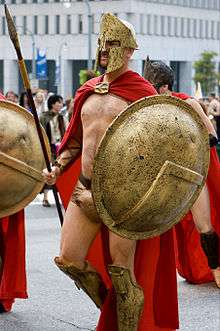Spartan army
| Sparta |
 Zeus on his throne with his eagle This article is part of the series: |
| Great Rhetra Laws of Lycurgus Politeia |
|---|
| List of Kings of Sparta Gerousia Ephorate Apella of the Damos Spartiates Perioeci Helots Agoge Syssitia |
|
Spartan army • Other Greek city-states • Law Portal |
The Spartan army stood at the centre of the Spartan state, whose citizens were trained in the discipline and honor of the warrior society.[1] Subject to military drill from early manhood, the Spartans were one of the most feared military forces in the Greek world. At the height of Sparta's power – between the 6th and 4th centuries BC – it was commonly accepted that "one Spartan was worth several men of any other state."[1] According to Thucydides, the famous moment of Spartan surrender on the island of Sphacteria, off Pylos, was highly unexpected. He said that "it was the common perception at the time that Spartans would never lay down their weapons for any reason, be it hunger, or danger."
The iconic army was first developed by the semi-mythical Spartan legislator Lycurgus.[2] Referring to Sparta having a "wall of men, instead of bricks", he proposed to reform Spartan society to create a military-focused lifestyle in accordance with "proper virtues" such as equality for the male citizens, austerity, strength, and fitness. A Spartan man's involvement with the army began in infancy when he was inspected by the Gerousia. If the baby was found to be weak or deformed he was left at Mount Taygetus to die, since the world of the Spartans was no place for those who could not fend for themselves. It should be noted, however, that the practice of discarding children at birth took place in Athens as well. Those deemed strong were then put in the agoge regime at the age of seven. Under the agoge the young boys or Spartiates were kept under intense and rigorous military training.[3] Their education focused primarily on cunning, sports and war tactics, but also included poetry, music, academics, and sometimes politics. Those who passed the agoge by the age of 30 were given full Spartan citizenship.
The term "spartan" became synonymous with fearlessness, harsh and cruel life, endurance or simplicity by design.[4]
Mycenaean age
The first reference to the Spartans at war is in the Iliad, in which they featured among the other Greek contingents. Like the rest of the Mycenaean-era armies, it was depicted as composed largely of infantry, equipped with short swords, spears, and Dipylon-type ("8"-shaped simple round bronze shields). This was the Golden Age of Warfare.
Each opposing army tried to fight through the other line on the right (strong or deep) side and then turn left; wherefore they would be able to attack the vulnerable flank. When this happened, it as a rule caused the army to be routed. The fleeing enemy were put to the sword only as far as the field of battle extended. The outcome of this one battle would determine the outcome of a particular issue. In the Golden Age of War defeated armies were not massacred; they fled back to their city and conceded superiority to the victors. It wasn't until after the Peloponnesus War that indiscriminate slaughter, enslavement and depredations were countenanced among the Greeks.
War chariots were used by the elite, but unlike their counterparts in the Middle East, they appear to have been used for transport, with the warrior dismounting to fight on foot and then remounting to withdraw from combat, although some accounts show warriors throwing their spear from the chariot before dismounting.[5]
Archaic Age and expansion
Mycenaean Sparta, like much of Greece, was engulfed in the Dorian invasions, which ended the Mycenaean civilization and ushered in the so-called "Greek Dark Ages". During this time, Sparta (or Lacedaemon) was merely a Doric village on the banks of the river Eurotas in Laconia. However, in the early 8th century BC, Spartan society was transformed. The reforms, which were ascribed by later tradition to the possibly mythical figure of Lycurgus, created new institutions and established the military nature of the Spartan state.[6] This "constitution of Lycurgus" remained essentially unchanged for five centuries.[6] From ca. 750 BC, Sparta embarked on a steady expansion, first by subduing Amyclae and the other settlements of Laconia, and later, in the First Messenian War, conquering the fertile country of Messenia. By the beginning of the 7th century BC, Sparta was, along with Argos, the dominant power in the Peloponnese.
Establishment of Spartan hegemony over the Peloponnese
Inevitably, these two powers collided. Initial Argive successes, such as the victory at the Battle of Hysiai in 669 BC, led to an uprising of the Messenians, which tied down the Spartan army for almost 20 years.[7] Over the course of the 6th century, Sparta secured her control of the Peloponnese peninsula: Arcadia was forced to recognize Spartan overlordship; Argos lost Cynuria (the SE coast of the Peloponnese) in about 546 and suffered a further crippling blow from Cleomenes I at the Battle of Sepeia in 494, while repeated expeditions against tyrannical regimes throughout Greece greatly raised their prestige.[8] By the early 5th century, Sparta was the unchallenged master in southern Greece, as the leading power (hegemon) of the newly established Peloponnesian League (which was more characteristically known to its contemporaries as "the Lacedaemonians and their allies").[9]
Persian and Peloponnesian Wars
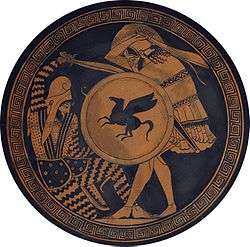
By the late 6th century BC, Sparta was recognized as the preeminent Greek city-state. King Croesus of Lydia established an alliance with the Spartans,[10] and later, the Greek cities of Asia Minor appealed to them for help during the Ionian Revolt.[10] In the second Persian invasion of Greece, under Xerxes, Sparta was assigned the overall leadership of Greek forces on land and at sea. The Spartans played a crucial role in the repulsion of the invasion, notably at the battles of Thermopylae and Plataea. In the aftermath, however, due to the plottings of Pausanias with the Persians and their unwillingness to campaign too far from home, the Spartans withdrew into a relative isolation, leaving the rising power of Athens to lead the continued effort against the Persians. This isolationist tendency was further reinforced by the revolts of some of her allies and a great earthquake in 464, which was followed by a large scale revolt of the Messenian helots.[8]
The parallel rise of Athens as a major power in Greece led to friction with Sparta, and to two large-scale conflicts, (the First and Second Peloponnesian Wars), which devastated Greece. Sparta suffered several defeats during these wars, including, for the first time, the surrender of an entire Spartan unit at Sphacteria in 425 BC, but ultimately emerged victorious, primarily through the aid it received from the Persians. Under its admiral Lysander, the Persian-funded Peloponnesian fleet captured the cities of the Athenian alliance, and a decisive naval victory at Aegospotami forced Athens to capitulate.[8] The Athenian defeat left Sparta and its military forces in a dominant position in Greece.
End of Hegemony
Spartan ascendancy did not last long. By the end of the 5th century BC, Sparta had suffered serious casualties in the Peloponnesian Wars, and its conservative and narrow mentality alienated many of its former allies. At the same time, its military class - the Spartiate caste - was in decline for several reasons:
- Population decline due to Sparta's frequent wars in the late 5th century. Since Spartiates were required to marry late, birth rates remained low, making it difficult to replace their losses.
- One could be demoted from Spartiate status for a number of reasons such as cowardice in battle or the inability to pay for membership in the syssitia. Inability to pay became such an increasingly severe problem because commercial activity had started to develop in Sparta. Some Spartiates had to sell the land from which they drew their income. As the constitution made no provisions for promotion to Spartiate caste, numbers gradually dwindled.
As Sparta's military power waned, Thebes repeatedly challenged its authority. The ensuing Corinthian War led to the humiliating Peace of Antalcidas that destroyed Sparta's reputation as the protector of the independence of Greek city-states. At the same time, Spartan military prestige suffered a severe blow when a mora of 600 men was decimated by peltasts (light troops) under the command of the Athenian general Iphicrates. Spartan authority finally collapsed after their disastrous defeat at the Battle of Leuctra by the Thebans commanded by Epaminondas in 371 BC. The battle, in which large numbers of Spartiates were killed, resulted in the loss of the fertile Messenia region.
Army organization
Social structure
| "... the allies of the Lacedaemonians were offended at Agesilaus, because ... they themselves [provided] so many [soldiers], and the Lacedaemonians, whom they followed, so few. ... Agesilaus, wishing to refute their argument with numbers ... ordered all the allies to sit down by themselves promiscuously, the Lacedaemonians apart by themselves. Then his herald called upon the potters to stand up first, and after them the smiths, next, the carpenters in their turn, and the builders, and so on through all the handicrafts. In response, almost all the allies rose up, but not a man of the Lacedaemonians; for they were forbidden to learn or practice a manual art. Then Agesilaus said with a laugh: 'You see, O men, how many more soldiers than you we are sending out.'" |
| Plutarch, The Life of Agesilaus, 26 |
The Spartan people (the "Lacedaemonians") were divided into three classes:
- Full citizens, known as the Spartiates proper, or Hómoioi ("equals" or peers), who received a grant of land (kláros or klēros, "lot") for their military service.
- Perioeci (the "dwellers nearby"), free non-citizens, generally merchants, craftsmen and sailors, who were used as light infantry and on auxiliary roles on campaign.[9]
- The third and most numerous class were the Helots, state-owned serfs used to farm the Spartiate klēros. By the 5th century BC, the helots too were used as light troops in skirmishes.[1]
The Spartiates were the core of the Spartan army: they participated in the Assembly (Apella) and provided the hoplites in the army. Indeed, they were supposed to be soldiers and nothing else, being forbidden to learn and exercise any other trade.[1] To a large degree, the constant war footing of Spartan society was needed to keep the vastly more numerous helots subdued.[11] One of the major problems of later Spartan society was the steady decline in fully enfranchised citizens, which also meant a decline in available military manpower: the number of Spartiates decreased from 6,000 in 640 BC to 1,000 in 330 BC.[12] The Spartans were therefore forced to use helot hoplites, and occasionally they freed some of the Laconian helots, the neodamōdeis (the "newly enfranchised"), and gave them land to settle in exchange for military service.[13]
The Spartiate population was subdivided into age groups. The youngest at 20 were counted as weaker due to lack of experience, and the oldest, up to 60 or in a crisis 65, were only called up in an emergency, to defend the baggage train.
Tactical structure
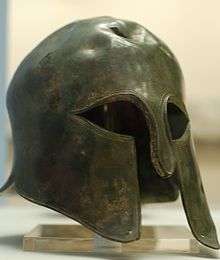
The principal source for the organization of the Spartan Army is Xenophon, who admired the Spartans and whose Constitution of Sparta offers a detailed overview of the Spartan state and society at the beginning of the 4th century BC. Other authors, notably Thucydides, also provide information, but it is not always as reliable as Xenophon's first-hand accounts.[14]
Little is known of the earlier organisation, and much is left open to speculation. The earliest form of social and military organization (during the 7th century BC) seems to have been the three tribes (phylai: the Pamphyloi, Hylleis and Dymanes), who appear in the Second Messenian War (685–668 BC). A further subdivision was the "fraternity" (phratra), of which 27, or nine per tribe, are recorded.[15] Eventually this system was replaced by five territorial divisions, the obai ("villages"), which supplied a lochos of ca. 1,000 men each.[16] This system was still used during the Persian Wars, as implied by references to the lochoi made by Herodotus in his history.[17]
The changes that occurred between the Persian and the Peloponnesian Wars are not documented, but according to Thucydides, at Mantinea in 418 BC there were 7 lochoi present, each subdivided into four pentekostyes of 128 men, which were further subdivided into four enōmotiai of 32 men, giving a total of 3,584 men for the main Spartan army.[18] By the end of the Peloponnesian War, the structure had evolved further, both to address the shortages in manpower and to create a more flexible system that allowed the Spartans to send smaller detachments on campaign or to garrisons outside their homeland.[19] According to Xenophon, the basic Spartan unit remained the enōmotia, with 36 men in three files of twelve under an enōmotarches.[20] Two enōmotiai formed a pentēkostys of 72 men under a pentēkontēr, and two pentēkostyai were grouped into a lochos of 144 men under a lochagos. Four lochoi formed a mora of 576 men under a polemarchos, the largest single tactical unit of the Spartan army.[21] Six morai composed the Spartan army on campaign, to which were added the Skiritai and the contingents of allied states.
The kings and the hippeis
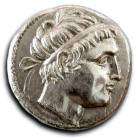
The full army was nominally led in battle by the two kings; initially, both went on campaign, but after the 6th century BC only one, with the other remaining at home.[6] Unlike other states, their authority was severely circumscribed; actual power rested with the five elected ephoroi.[1] The kings were accompanied by a select group of 300 men as a royal guard, who were termed hippeis ("cavalrymen"). Despite their title, they were infantry hoplites like all Spartiatai. Indeed, the Spartans did not utilize a cavalry of their own until late into the Peloponnesian War, when small units of 60 cavalrymen were attached to each mora.[21] The hippeis belonged to the first mora and were the elite of the Spartan army, being deployed on the honorary right side of the battle line. They were selected every year by specially commissioned officials, the hippagretai, from among experienced men who had sons, so that their line would continue.[17]
Training
| "Ὦ ξεῖν’, ἀγγέλλειν Λακεδαιμονίοις ὅτι τῇδε κείμεθα, τοῖς κείνων ῥήμασι πειθόμενοι." "Go tell the Spartans, thou that passest by, that here, obedient to their laws, we lie." |
| Simonides of Ceos, Epitaph on the burial mound of the Spartans who fell at Thermopylae[22] |
At first, in the archaic period of 700–600 BC, education for both sexes was, as in most Greek states, centred on the arts, with the male citizen population later receiving military education. However, from the 6th century onwards, the military character of the state became more pronounced, and education was totally subordinated to the needs of the military.[23]
Both boys and girls were brought up by the city women until the age of seven, when boys (paidia) were taken from their mothers and grouped together in "packs" (agelai) and were sent to what is almost equivalent to present-day military boot camp. This military camp was known as the Agoge. They became inured to hardship, being provided with scant food and clothing; this also encouraged them to steal, and if they were caught, they were punished – not for stealing, but for being caught.[11] There is a characteristic story, told by Plutarch: "The boys make such a serious matter of their stealing, that one of them, as the story goes, who was carrying concealed under his cloak a young fox which he had stolen, suffered the animal to tear out his bowels with its teeth and claws, and died rather than have his theft detected."[24] The boys were encouraged to compete against one another in games and mock fights and to foster an esprit de corps. In addition, they were taught to read and write and learned the songs of Tyrtaios, that celebrated Spartan exploits in the Second Messenian War. They learned to read and write not for cultural reasons, but so they could be able to read military maps.[25] At the age of twelve, a boy was classed as a "youth" (meirakion). His physical education was intensified, discipline became much harsher, and the boys were loaded with extra tasks. The youths had to go barefoot, and were dressed only in a tunic both in summer and in winter.[11]
Adulthood was reached at the age of 18, and the young adult (eiren) initially served as a trainer for the boys. At the same time, the most promising youths were included in the Krypteia. At 20, Spartans became eligible for military service and joined one of the messes (syssitia), which included 15 men of various ages.[26] Those who were rejected retained a lesser form of citizenship, as only the soldiers were ranked among the homoioi. However, even after that, and even during marriage and until about the age of 30, they would spend most of their day in the barracks with their unit. Military duty lasted until the 60th year, but there are recorded cases of older people participating in campaigns in times of crisis.[15]
Throughout their adult lives, the Spartiates continued to be subject to a training regime so strict that, as Plutarch says, "... they were the only men in the world with whom war brought a respite in the training for war."[27] Bravery was the ultimate virtue for the Spartans: Spartan mothers would give their sons the shield with the words "[Return] With it or [carried] on it!" (Ἢ τὰν ἢ ἐπὶ τᾶς),[28] that is to say, either victorious or dead, since in battle, the heavy hoplite shield would be the first thing a fleeing soldier would be tempted to abandon –- rhipsaspia, "dropping the shield", was a synonym for desertion in the field.[29]
The army on campaign
Tactics

Like the armies of the other Greek states, the Spartan army was an infantry-based army that fought using the phalanx formation. The Spartans themselves did not introduce any significant changes or tactical innovations in hoplite warfare, but their constant drill and superb discipline made their phalanx much more cohesive and effective. The Spartans employed the phalanx in the classical style in a single line, uniformly deep in files of 8 to 12 men. When fighting alongside their allies, the Spartans would normally occupy the honorary right flank. If, as usually happened, the Spartans achieved victory on their side, they would then wheel left and roll up the enemy formation.[30]
During the Peloponnesian War, engagements became more fluid, light troops became increasingly used and tactics evolved to meet them, but in direct confrontations between two opposing phalanxes, stamina and "pushing ability" were what counted.[31] It was only when the Thebans, under Epaminondas increased the depth of a part of their formation at the Battle of Leuctra that the Spartan phalanx broke.
On the march
According to Xenophon, the army was mobilized by the ephors, and after a series of religious ceremonies and sacrifices, the army assembled and set out.[32] The army proceeded led by the king, with the skiritai and cavalry detachments acting as an advance guard and scouting parties.[33] The necessary provisions (barley, cheese, onions and salted meat) were carried along with the army, and each Spartan was accompanied by a helot manservant.[34] Each mora marched and camped separately, with its own baggage train.[35] Sacrifice was given every morning and before battle by the king and the officers; if the omens were not favourable, a pious leader might refuse to march or to engage the enemy.[36] The only people who could have a gravestone were women who died in child birth and warriors who died in battle; both were considered lives given for the state.
Clothing, arms and armor
The Spartans used the same typical hoplite equipment as the other Greek neighbors; the only distinctive Spartan features were the crimson tunic (chitōn) and cloak (himation),[37] and long hair, which the Spartans retained to a far later date than most Greeks. To the Spartans, long hair retained its older Archaic meaning as the symbol of a free man; to the other Greeks, by the 5th century, its peculiar association with the Spartans had come to signify pro-Spartan sympathies.[38]
Classical period
The letter lambda (Λ), standing for Laconia or Lacedaemon, which was painted on the Spartans' shields, was first adopted in the 420s BC, and quickly became a widely known Spartan symbol.[39] Military families passed on their shields to each generation as family heirlooms. The technical evolution and design of Spartan shields evolved from bashing and shield wall tactics, and were of such great importance in the Spartan army that while losing a sword and a spear was an exception, to lose a shield was a sign of disgrace. Not only does it protect the user, but it also protects the whole phalanx formation. To come home without the shield was the mark of a deserter; rhipsaspia or "dropping the shield", was a synonym for desertion in the field. Mothers bidding farewell to their sons would encourage them to come back with their shields, often saying goodbyes like "Son, either with this or on this" (Ἢ τὰν ἢ ἐπὶ τᾶς).[40][41]
Spartan hoplites were often depicted bearing a transverse horsehair crest on their helmet, which was possibly used to identify officers.[42] In the Archaic period, Spartans were armored with flanged bronze cuirasses, leg greaves, and a helmet, often of the Corinthian type. It is often disputed which torso armor the Spartans wore during the Persian Wars, though it seems likely they either continued to wear bronze cuirasses of a more sculptured type, or instead had adopted the linothōrax. During the later 5th century BC, when warfare had become more flexible and full-scale phalanx confrontations became rarer, the Greeks abandoned most forms of body armor. The Lacedaemonians also adopted a new tunic, the exōmis, which could be arranged so that it left the right arm and shoulder uncovered and free for action in combat.[43]
The Spartan's main weapon was the dory spear. For long range, they carried a javelin. The Spartiates were always armed with a xiphos as a secondary weapon. Among most Greek warriors, this weapon had an iron blade of about 60 centimeters; however, the Spartan version was typically only 30-45 centimetres. The Spartans' shorter weapon proved deadly in the crush caused by colliding phalanxes formations – it was capable of being thrust through gaps in the enemy's shield wall and armor, where there was no room for longer weapons. The groin and throat were among the favorite targets. In one account, an Athenian asked a Spartan why his sword was so short and after a short pause he replied, "It's long enough to reach your heart." In another, a Spartan complained to his mother that the sword was short, to which she simply told him to step closer to the enemy. As an alternative to the xiphos, some Spartans selected the kopis as their secondary weapon. Unlike the xiphos, which is a thrusting weapon, the kopis was a hacking weapon in the form of a thick, curved iron sword. In Athenian art, Spartan hoplites were often depicted using a kopis instead of the xiphos, as the kopis was seen as a quintessential "bad guys" weapon in Greek eyes.[44] The Spartans retained the traditional hoplite phalanx until the reforms of Cleomenes III, when they were re-equipped with the Macedonian sarissa and trained in the style of the phalanx.
Spartans trained in pankration, a famous martial art in Ancient Greece that consisted of boxing and grappling. Spartans were so adept in pankration that, when it was inducted in the Olympic Games, they were mostly forbidden to compete.
Hellenistic period
During the Hellenistic period Spartan equipment evolved drastically. Since the early 5th century BC the pilos helmet had become almost standard within the Spartan army, being in use by the Spartans until the end of the Classical era. Also after the "Iphicratean reforms" peltasts became a much more common sight on the Greek battlefield and themselves become more heavily armed. In response to Iphicrates' victory over Sparta in 392 BC, Spartan hoplites started abandoning body armour and eventually wore almost no armour apart from a shield, leg greaves, bracelets, helmet and a robe. In later periods Spartans did start to readopt armour, but on a much lesser scale than during the Archaic period. Finally during 227 BC, Cleomenes' reforms introduced updated equipment to Sparta, including the Macedonian sarissa (pike). However pike-men armed with the sarissa never outnumbered troops equipped in the hoplite style. It was also in that time Sparta adopted its own cavalry and archers.
Philosophy, education and the Spartan code

Spartan philosophy
Contrary to popular belief, Spartans valued knowledge and education more than the Athenians did.[45] Spartan philosophers include Lycurgus and Chilon of Sparta. Although Athens has been praised as the "inventor" of democracy and philosophy, Sparta often has been viewed in popular culture as a society characterized by brutal, mindless discipline and merciless emphasis on physical fitness. Sparta, however, had its own democratic government. Sparta also wasn't a totalitarian state as many believed. In the Appella or Demos as early as 700 BC, Spartans elect leaders and voted by range voting and shouting. Every male age 30 and above could participate. Aristotle called the Spartan electoral process "childish" in contrast to the stone ballots cast by the Athenians. Sparta adopted its procedure for the sake of simplicity, and to prevent any bias voting, bribing, or cheating that was predominant in the early democratic elections.[46]
Spartan education
The Spartan public education system, the agoge, trained the mind as well as the body. Spartans were not only literate, but admired for their intellectual culture and poetry. Socrates said the "most ancient and fertile homes of philosophy among the Greeks are Crete and Sparta, where are found more sophists than anywhere on earth."[47] Public education was provided for girls as well as boys, and consequently literacy rate was higher in Sparta than in other Greek city-states.[48] In education, sports was given the most emphasis in teaching.[48]
Self-discipline, not kadavergehorsam (mindless obedience) was the goal of Spartan education. Sparta placed the values of liberty, equality, and fraternity at the center of their ethical system. These values applied to every full Spartan citizen, immigrant, merchant, and even to the helots, but not to the dishonored. Helots are unique in the history of slavery in that unlike traditional slaves, they were allowed to keep and gain wealth. They could keep half their agricultural produce and presumably sell it; thus accumulating wealth. There are known to have been some occasions that a helot with enough money was allowed to purchase their freedom from the state.[49]
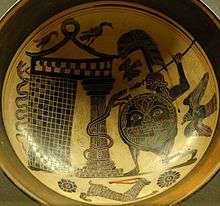
Spartan code of honor
The Spartan hoplite followed a strict laconic code of honor. No soldier was considered superior to another.[48] Suicidal recklesness, berserkery, and rage were prohibited in a Spartan army, as these behaviors endangered the phalanx. Recklessness could lead to dishonor, as in the case of Aristodemus.[50] Spartans regarded those who fight, while still wishing to live, as more valorous than those who don't care if they die.[50] They believed that a warrior must not fight with raging anger, but with calmed determination.[51] By the laconic way of life, Spartans must walk without any noise, and speak only with few words.[48] Other ways for Spartans to be dishonored were dropping the shield (rhipsaspia), failing to complete the training, and deserting in battle. Dishonored Spartans were labeled outcasts, and were forced to wear different clothing for public humiliation.[48] In battle, stories of valor were told to inspire troops and, before a major confrontation, they sang soft songs to calm the nerves.[52]
Spartan Navy
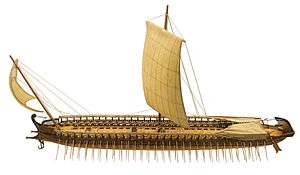
Throughout their history, the Spartans were a land based force par excellence. During the Persian Wars, they contributed a small navy of 20 triremes, and provided the overall fleet commander, but they largely relied on their allies, primarily the Corinthians, for naval power. This fact meant that, when the Peloponnesian War broke out, the Spartans were supreme on land, but the Athenians supreme at sea. The Spartans repeatedly ravaged Attica, but the Athenians kept being supplied by sea, and were able to stage raids of their own around the Peloponnese with their navy. Eventually, it was the creation of a navy that enabled Sparta to overcome Athens. With Persian gold, Lysander, appointed navarch in 407 BC, was able to master a strong navy, and successfully challenge and destroy Athenian predominance in the Aegean Sea.[8] The Spartan engagement with the sea would be short-lived, however, and did not survive the turmoils of the Corinthian War: in the Battle of Cnidus of 394 BC, the Spartan navy was decisively defeated by a joint Athenian-Persian fleet, marking the end of Sparta's brief naval supremacy. The final blow would be given 20 years later, at the Battle of Naxos in 376 BC. A small fleet was periodically maintained thereafter, but its effectiveness was limited; the last revival of Spartan naval power was under Nabis, who, with aid from his Cretan allies, created a fleet to control the Laconian coastline.
The fleet was commanded by navarchs, who were appointed for a strictly one-year term, and apparently could not be reappointed. The admirals were subordinated to the vice-admiral, called epistoleus. This position is seemingly independent of the one-year term clause, because it was used, in 405 B.C. to give Lysander command of the fleet after he was already an admiral for a year.
Wars and battles
Messenian Wars
Wars with Argos
Persian Wars
Athenian War
- Sybota
- Potidaea
- Chalcis
- Rhium
- Naupactus
- Mytilene
- Tanagra
- Olpae
- Pylos
- Sphacteria
- Amphipolis
- First Mantinea
- Sicilian Expedition
- Syme
- Cynossema
- Abydos
- Cyzicus
- Notium
- Arginusae
- Aegospotami
Corinthian War
Theban War
Cleomenean War
War against Nabis
In popular culture
- In the Halo universe, the SPARTAN program is a project designed to produce genetically augmented, power armored supersoldiers. The SPARTANs serve as the protagonists of several works and as major characters in many others; the main character of the Halo trilogy is John-117, a SPARTAN-II supersoldier, and the protagonist of Halo: Reach is SPARTAN-B312, a SPARTAN-III supersoldier. Twice in the novel Halo: Ghosts of Onyx, companies of 300 SPARTAN-IIIs are sent against numerically superior Covenant forces and succeed in their objective, but suffer almost 100% casualty rates, similar to the Battle of Thermopylae.
- The Gates of Fire, a novel by Steven Pressfield, which provides a gritty, first-person account of the Battle of Thermopylae from the view of a Helot.
- 300, a graphic novel and a movie based on the graphic novel, both interpreting the Battle of Thermopylae.
- Many colleges and universities have the Spartan as a school mascot, some of which include Michigan State University (see also Sparty, Michigan State's costumed mascot) and San Jose State University. The Spartan South Midlands Football League is an English football league named after them.
- Kratos, the main protagonist in God of War is a legendary Spartan demigod warrior and hero who also served the Spartan army as a high-ranking officer.
- A number of military aircraft have been named after the Spartans, including the Alenia C-27J Spartan, C-27A Spartan, and the Simmonds Spartan.
- On Season 1 of the television program Deadliest Warrior, the Spartan defeated the Ninja while in Season 2, the Spartan was brought back to defeat the Samurai.
- The Spartan army is the inspiration for a popular branded Obstacle Race, Spartan Race
See also
- List of Spartan kings
- Scytale
- Cryptia
- Clearchus of Sparta
- Xanthippus of Carthage
- Homosexuality in the Militaries of Ancient Greece
Notes and references
- 1 2 3 4 5 Connolly (2006), p. 38
- ↑ Plutarch, The Life of Lycurgus (written 75, trans. John Dryden 1683), The Internet Classics Archive
- ↑ Hodkinson, Stephen (1996). "Agoge". In Hornblower, Simon. Oxford Classical Dictionary. Oxford: Oxford University Press.
- ↑ Oxford Dictionary
- ↑ Warry (2004), pp. 14–15
- 1 2 3 Sekunda (1998), p. 4
- ↑ Sekunda (1998), pp. 6–7
- 1 2 3 4 Sekunda (1998), p. 7
- 1 2 Connolly (2006), p. 11
- 1 2 Holland, Tom. Persian Fire: The First World Empire and the Battle for the West. Anchor. ISBN 0-307-27948-0.
- 1 2 3 Connolly (2006), p. 39
- ↑ Lane Fox, Robin. The Classical World: An Epic History from Homer to Hadrian. Basic Books. ISBN 0-465-02496-3.
- ↑ Sekunda (1998), pp. 16–17
- ↑ Connolly (2006), pp. 38–39
- 1 2 Sekunda (1998), p. 13
- ↑ Sekunda (1998), p. 14
- 1 2 Connolly (2006), p. 41
- ↑ Thucydides, History of the Peloponnesian War 5.68.2
- ↑ Sekunda (1998), p. 15
- ↑ Until the late 5th century, however, each file seems to have had a depth of only 8 men. Connolly (2006), p. 40
- 1 2 Connolly (2006), p. 40
- ↑ Herodotus, 7.228.1
- ↑ Encyclopædia Britannica 15th Edition
- ↑ Plutarch, The Life of Lycurgus, 18.1
- ↑ Sekunda (1998), pp. 10–11
- ↑ Sekunda (1998), p. 12
- ↑ Plutarch, The Life of Lycurgus, 22.2
- ↑ Plutarch, Moralia, Sayings of Spartan Women 241.F
- ↑ Miller, William Ian (2002). The mystery of courage. Harvard University Press, 2002. p. 98. ISBN 978-0-674-00826-7.
- ↑ Sekunda (1998), p. 19
- ↑ "Spartan armor". Marvel Comics. July 16, 2012. Retrieved July 16, 2012.
- ↑ Sekunda (1998), p. 17
- ↑ Sekunda (1998), p. 18
- ↑ Connolly (2006), p. 44
- ↑ Connolly (2006), pp. 46–47
- ↑ Connolly (2006), p. 47
- ↑ Sekunda (1998), p. 20
- ↑ Sekunda (1998), p. 24
- ↑ Sekunda (1998), p. 27; disputed by Campbell (2012)
- ↑ Spartan Quotes
- ↑ History of the Spartan Shield
- ↑ Sekunda (1986), pp.3 & 6
- ↑ Sekunda (1998), p. 21
- ↑ Spartan Weaponry
- ↑ Soriano (2005), pp. 84–85
- ↑ Full historical description of the Spartan government
- ↑ Plato, Protagoras, 343b:366.
- 1 2 3 4 5 Soriano (2005), p. 85
- ↑ Cleomenes III in 223/2 BC allowed Helots to become free by paying 500 drachmas; 6000 helots paid.
- 1 2 Schmitz vol 1. p304
- ↑ Soriano (2005), pp. 87–89
- ↑ Soriano (2005), pp. 90–91
Sources
- Campbell, Duncan B (2012). Spartan Warrior (Warrior Series #163). Osprey Publications. ISBN 978-1-84908-700-1.
- Connolly, Peter (2006). Greece and Rome at War. Greenhill Books. ISBN 978-1-85367-303-0.
- Lazenby, John (1985). The Spartan Army. Aris & Phillips Ltd. ISBN 0-86516-115-1.
- Sekunda, Nicholas (1986). The Ancient Greeks: Armies of Classical Greece, 5th and 4th Centuries BC (Elite Series #7). Osprey Publications. ISBN 0-85045-686-X.
- Sekunda, Nicholas (1998). The Spartan Army (Elite Series #60). Osprey Publications. ISBN 1-85532-659-0.
- Soriano, Celia (2005). Kayamanan III: History of the World (2005 Ed). Rex Bookstore, Inc. ISBN 971-23-4042-2.
- Warry, John (2004). Warfare in the Classical World. University of Oklahoma Press. ISBN 0-8061-2794-5.
